Identifying Ecological Security Patterns Considering the Stability of Ecological Sources in Ecologically Fragile Areas
Abstract
1. Introduction
2. Study Area and Data Collection
2.1. Study Area
2.2. Data Sources and Processing
3. Methods
3.1. Identification of Ecological Sources Considering Stability
3.1.1. ESI Assessment for the Years 2000, 2010, and 2020
3.1.2. Construction of Change Monitoring Model for ESI
3.1.3. Assessing the Stability and Identifying the Preliminary Stable Sources
3.1.4. Determination of Final Ecological Sources
3.2. Construction of the Comprehensive Resistance Surface
3.3. Determination of Ecological Corridors and Ecological Strategic Nodes
3.3.1. Extraction of Ecological Corridors
3.3.2. Extraction of Pinch Points, Barriers, and Breakpoints
4. Results
4.1. Spatial Distribution of Ecological Sources
4.1.1. Spatial–Temporal Distribution of Ecosystem Services
4.1.2. Spatial Patterns of the ESI
4.1.3. Overall Change Patterns of the ESI
4.1.4. The Distribution Characteristics of Ecological Sources
4.2. Analysis of Ecological Resistance Surface
4.3. Construction of the ESP
5. Discussion
5.1. Application of ESP Framework Considering Source Stability
5.2. Management Implications Based on the Identified ESP
6. Conclusions
- (1)
- A total of 93 stable ecological sources were identified in the NHAR and primarily located in its southern, central, and eastern regions. The dominant land use types within these sources included grassland, forest, and cropland. These sources were critical for regional ecological conservation, providing the region with stable and high-quality ecosystem services.
- (2)
- The ecological resistance surface was collectively shaped by natural conditions, human disturbance, and environmental response factors, with the impact of natural conditions and human disturbances being particularly significant. The distribution of resistance surfaces showed significant spatial variation, with high resistance values mainly concentrated in urban areas, regions with dense road networks, and desert zones.
- (3)
- This study identified 4160.67 km of ecological corridors, including 691.45 km of key corridors, 1888.66 km of important corridors, and 1580.56 km of general corridors, and various types of corridors played diverse roles in maintaining stable ecological connectivity across the region. Additionally, the identified 231 ecological pinch points, 45 barriers, and 154 breakpoints were significant for enhancing connectivity and should be prioritized for ecological protection and restoration. The constructed ESP can serve as a key area for preserving regional sustainable landscapes and as a foundation for future optimization of ecological planning.
Supplementary Materials
Author Contributions
Funding
Data Availability Statement
Acknowledgments
Conflicts of Interest
References
- Modica, G.; Praticò, S.; Laudari, L.; Ledda, A.; Di Fazio, S.; De Montis, A. Implementation of multispecies ecological networks at the regional scale: Analysis and multi-temporal assessment. J. Environ. Manag. 2021, 289, 112494. [Google Scholar] [CrossRef] [PubMed]
- Wei, L.; Zhou, L.; Sun, D.; Yuan, B.; Hu, F. Evaluating the impact of urban expansion on the habitat quality and constructing ecological security patterns: A case study of Jiziwan in the Yellow River Basin, China. Ecol. Indic. 2022, 145, 109544. [Google Scholar] [CrossRef]
- Peng, J.; Yang, Y.; Liu, Y.; Hu, Y.n.; Du, Y.; Meersmans, J.; Qiu, S. Linking ecosystem services and circuit theory to identify ecological security patterns. Sci. Total Environ. 2018, 644, 781–790. [Google Scholar] [CrossRef] [PubMed]
- Jia, Q.; Jiao, L.; Lian, X.; Wang, W. Linking supply-demand balance of ecosystem services to identify ecological security patterns in urban agglomerations. Sustain. Cities Soc. 2023, 92, 104497. [Google Scholar] [CrossRef]
- Ding, M.; Liu, W.; Xiao, L.; Zhong, F.; Lu, N.; Zhang, J.; Zhang, Z.; Xu, X.; Wang, K. Construction and optimization strategy of ecological security pattern in a rapidly urbanizing region: A case study in central-south China. Ecol. Indic. 2022, 136, 108604. [Google Scholar] [CrossRef]
- Yu, K. Security patterns and surface model in landscape ecological planning. Landsc. Urban Plan. 1996, 36, 1–17. [Google Scholar] [CrossRef]
- Fan, F.; Liu, Y.; Chen, J.; Dong, J. Scenario-based ecological security patterns to indicate landscape sustainability: A case study on the Qinghai-Tibet Plateau. Landsc. Ecol. 2021, 36, 2175–2188. [Google Scholar] [CrossRef]
- Peng, J.; Zhao, S.; Dong, J.; Liu, Y.; Meersmans, J.; Li, H.; Wu, J. Applying ant colony algorithm to identify ecological security patterns in megacities. Environ. Model. Softw. 2019, 117, 214–222. [Google Scholar] [CrossRef]
- Dai, L.; Liu, Y.; Luo, X. Integrating the MCR and DOI models to construct an ecological security network for the urban agglomeration around Poyang Lake, China. Sci. Total Environ. 2021, 754, 141868. [Google Scholar] [CrossRef]
- Jongman, R.H.G.; Külvik, M.; Kristiansen, I. European ecological networks and greenways. Landsc. Urban Plan. 2004, 68, 305–319. [Google Scholar] [CrossRef]
- Bennett, A.F. Linkages in the Landscape: The Role of Corridors and Connectivity in Wildlife Conservation; IUCN: Gland, Switzerland; Cambridge, UK, 2003. [Google Scholar]
- Tzoulas, K.; Korpela, K.; Venn, S.; Yli-Pelkonen, V.; Kaźmierczak, A.; Niemela, J.; James, P. Promoting ecosystem and human health in urban areas using Green Infrastructure: A literature review. Landsc. Urban Plan. 2007, 81, 167–178. [Google Scholar] [CrossRef]
- Long, Y.; Han, H.; Lai, S.-K.; Mao, Q. Urban growth boundaries of the Beijing Metropolitan Area: Comparison of simulation and artwork. Cities 2013, 31, 337–348. [Google Scholar] [CrossRef]
- Chen, W.; Zhao, H.; Li, J.; Zhu, L.; Wang, Z.; Zeng, J. Land use transitions and the associated impacts on ecosystem services in the Middle Reaches of the Yangtze River Economic Belt in China based on the geo-informatic Tupu method. Sci. Total Environ. 2020, 701, 134690. [Google Scholar] [CrossRef] [PubMed]
- Gou, M.; Li, L.; Ouyang, S.; Shu, C.; Xiao, W.; Wang, N.; Hu, J.; Liu, C. Integrating ecosystem service trade-offs and rocky desertification into ecological security pattern construction in the Daning river basin of southwest China. Ecol. Indic. 2022, 138, 108845. [Google Scholar] [CrossRef]
- Wei, H.; Zhu, H.; Chen, J.; Jiao, H.; Li, P.; Xiong, L. Construction and Optimization of Ecological Security Pattern in the Loess Plateau of China Based on the Minimum Cumulative Resistance (MCR) Model. Remote Sens. 2022, 14, 5906. [Google Scholar] [CrossRef]
- Aminzadeh, B.; Khansefid, M. A case study of urban ecological networks and a sustainable city: Tehran’s metropolitan area. Urban Ecosyst. 2010, 13, 23–36. [Google Scholar] [CrossRef]
- Yang, Z.; Ma, C.; Liu, Y.; Zhao, H.; Hua, Y.; Ou, S.; Fan, X. Provincial-Scale Research on the Eco-Security Structure in the Form of an Ecological Network of the Upper Yellow River: A Case Study of the Ningxia Hui Autonomous Region. Land 2023, 12, 1341. [Google Scholar] [CrossRef]
- Xu, W.; Wang, J.; Zhang, M.; Li, S. Construction of landscape ecological network based on landscape ecological risk assessment in a large-scale opencast coal mine area. J. Clean. Prod. 2021, 286, 125523. [Google Scholar] [CrossRef]
- Li, H.; Chen, H.; Wu, M.; Zhou, K.; Zhang, X.; Liu, Z. A Dynamic Evaluation Method of Urban Ecological Networks Combining Graphab and the FLUS Model. Land 2022, 11, 2297. [Google Scholar] [CrossRef]
- Li, L.; Huang, X.; Wu, D.; Wang, Z.; Yang, H. Optimization of ecological security patterns considering both natural and social disturbances in China’s largest urban agglomeration. Ecol. Eng. 2022, 180, 106647. [Google Scholar] [CrossRef]
- Huang, L.; Wang, J.; Fang, Y.; Zhai, T.; Cheng, H. An integrated approach towards spatial identification of restored and conserved priority areas of ecological network for implementation planning in metropolitan region. Sustain. Cities Soc. 2021, 69, 102865. [Google Scholar] [CrossRef]
- Wang, Z.; Luo, K.; Zhao, Y.; Lechner, A.M.; Wu, J.; Zhu, Q.; Sha, W.; Wang, Y. Modelling regional ecological security pattern and restoration priorities after long-term intensive open-pit coal mining. Sci. Total Environ. 2022, 835, 155491. [Google Scholar] [CrossRef] [PubMed]
- Shen, Z.; Wu, W.; Chen, S.; Tian, S.; Wang, J.; Li, L. A static and dynamic coupling approach for maintaining ecological networks connectivity in rapid urbanization contexts. J. Clean. Prod. 2022, 369, 133375. [Google Scholar] [CrossRef]
- Nie, W.; Xu, B.; Yang, F.; Shi, Y.; Liu, B.; Wu, R.; Lin, W.; Pei, H.; Bao, Z. Simulating future land use by coupling ecological security patterns and multiple scenarios. Sci. Total Environ. 2023, 859, 160262. [Google Scholar] [CrossRef]
- Nie, W.; Shi, Y.; Siaw, M.J.; Yang, F.; Wu, R.; Wu, X.; Zheng, X.; Bao, Z. Constructing and optimizing ecological network at county and town Scale: The case of Anji County, China. Ecol. Indic. 2021, 132, 108294. [Google Scholar] [CrossRef]
- Knaapen, J.P.; Scheffer, M.; Harms, B. Estimating habitat isolation in landscape planning. Landsc. Urban Plan. 1992, 23, 1–16. [Google Scholar] [CrossRef]
- McRae, B.H.; Dickson, B.G.; Keitt, T.H.; Shah, V.B. Using circuit theory to model connectivity in ecology, evolution, and conservation. Ecology 2008, 89, 2712–2724. [Google Scholar] [CrossRef] [PubMed]
- Zhang, Y.; Zhao, Z.; Fu, B.; Ma, R.; Yang, Y.; Lü, Y.; Wu, X. Identifying ecological security patterns based on the supply, demand and sensitivity of ecosystem service: A case study in the Yellow River Basin, China. J. Environ. Manag. 2022, 315, 115158. [Google Scholar] [CrossRef]
- Liu, H.; Niu, T.; Yu, Q.; Yang, L.; Ma, J.; Qiu, S.; Wang, R.; Liu, W.; Li, J. Spatial and temporal variations in the relationship between the topological structure of eco-spatial network and biodiversity maintenance function in China. Ecol. Indic. 2022, 139, 108919. [Google Scholar] [CrossRef]
- Zeng, W.; Tang, H.; Liang, X.; Hu, Z.; Yang, Z.; Guan, Q. Using ecological security pattern to identify priority protected areas: A case study in the Wuhan Metropolitan Area, China. Ecol. Indic. 2023, 148, 110121. [Google Scholar] [CrossRef]
- Lyu, R.; Clarke, K.C.; Zhang, J.; Feng, J.; Jia, X.; Li, J. Spatial correlations among ecosystem services and their socio-ecological driving factors: A case study in the city belt along the Yellow River in Ningxia, China. Appl. Geogr. 2019, 108, 64–73. [Google Scholar] [CrossRef]
- Snäll, T.; Triviño, M.; Mair, L.; Bengtsson, J.; Moen, J. High rates of short-term dynamics of forest ecosystem services. Nat. Sustain. 2021, 4, 951–957. [Google Scholar] [CrossRef]
- Lü, D.; Lü, Y.; Gao, G.; Sun, S.; Wang, Y.; Fu, B. A landscape persistence-based methodological framework for assessing ecological stability. Environ. Sci. Ecotechnol. 2024, 17, 100300. [Google Scholar] [CrossRef]
- Jóźwik, J.; Dymek, D. Spatial diversity of ecological stability in different types of spatial units: Case study of Poland. Acta Geogr. Slov. 2021, 61, 57–74. [Google Scholar] [CrossRef]
- Guilherme, F.; Gonçalves, J.A.; Carretero, M.A.; Farinha-Marques, P. Assessment of land cover trajectories as an indicator of urban habitat temporal continuity. Landsc. Urban Plan. 2024, 242, 104932. [Google Scholar] [CrossRef]
- Ji, X.; Wu, D.; Yan, Y.; Guo, W.; Li, K. Interpreting regional ecological security from perspective of ecological networks: A case study in Ningxia Hui Autonomous Region, China. Environ. Sci. Pollut. Res. 2023, 30, 65412–65426. [Google Scholar] [CrossRef]
- Xu, J.; Wang, S.; Xiao, Y.; Xie, G.; Wang, Y.; Zhang, C.; Li, P.; Lei, G. Mapping the spatiotemporal heterogeneity of ecosystem service relationships and bundles in Ningxia, China. J. Clean. Prod. 2021, 294, 126216. [Google Scholar] [CrossRef]
- Du, L.; Gong, F.; Zeng, Y.; Ma, L.; Qiao, C.; Wu, H. Carbon use efficiency of terrestrial ecosystems in desert/grassland biome transition zone: A case in Ningxia province, northwest China. Ecol. Indic. 2021, 120, 106971. [Google Scholar] [CrossRef]
- Dong, J.; Zhou, Y.; You, N. A 30-m Annual Maximum NDVI Dataset in China from 2000 to 2020. 2021. Available online: http://www.nesdc.org.cn/sdo/detail?id=60f68d757e28174f0e7d8d49 (accessed on 26 December 2023).
- Peng, S. 1-km Monthly Precipitation Dataset for China (1901–2022). 2020. Available online: http://loess.geodata.cn/data/datadetails.html?dataguid=192891852410344&docid=490 (accessed on 26 December 2023).
- Peng, S. 1 km Monthly Potential Evapotranspiration Dataset in China (1901–2022). 2022. Available online: http://loess.geodata.cn/data/datadetails.html?dataguid=34595274939620&docid=74 (accessed on 26 December 2023).
- Van Meerbeek, K.; Jucker, T.; Svenning, J.-C. Unifying the concepts of stability and resilience in ecology. J. Ecol. 2021, 109, 3114–3132. [Google Scholar] [CrossRef]
- Saura, S.; Torné, J. Conefor Sensinode 2.2: A software package for quantifying the importance of habitat patches for landscape connectivity. Environ. Model. Softw. 2009, 24, 135–139. [Google Scholar] [CrossRef]
- Feng, Z.; Jin, X.; Chen, T.; Wu, J. Understanding trade-offs and synergies of ecosystem services to support the decision-making in the Beijing–Tianjin–Hebei region. Land Use Pol. 2021, 106, 105446. [Google Scholar] [CrossRef]
- Xia, H.; Yuan, S.; Prishchepov, A.V. Spatial-temporal heterogeneity of ecosystem service interactions and their social-ecological drivers: Implications for spatial planning and management. Resour. Conserv. Recycl. 2023, 189, 106767. [Google Scholar] [CrossRef]
- Natural Capital Project. InVEST 3.14.1 User’s Guide. The Natural Capital Project. Stanford University, University of Minnesota, Chinese Academy of Sciences, The Nature Conservancy, World Wildlife Fund, Stockholm Resilience Centre and the Royal Swedish Academy of Sciences. Available online: https://naturalcapitalproject.stanford.edu/software/invest (accessed on 7 May 2003).
- Benavidez, R.; Jackson, B.; Maxwell, D.; Norton, K. A review of the (Revised) Universal Soil Loss Equation ((R)USLE): With a view to increasing its global applicability and improving soil loss estimates. Hydrol. Earth Syst. Sci. 2018, 22, 6059–6086. [Google Scholar] [CrossRef]
- Guo, Z.; Xie, Y.; Guo, H.; Zhang, X.; Wang, H.; Bie, Q.; Xi, G.; Ma, C. Do the ecosystems of Gansu Province in Western China’s crucial ecological security barrier remain vulnerable? Evidence from remote sensing based on geospatial analysis. J. Clean. Prod. 2023, 402, 136740. [Google Scholar] [CrossRef]
- Jiang, H.; Peng, J.; Dong, J.; Zhang, Z.; Xu, Z.; Meersmans, J. Linking ecological background and demand to identify ecological security patterns across the Guangdong-Hong Kong-Macao Greater Bay Area in China. Landsc. Ecol. 2021, 36, 2135–2150. [Google Scholar] [CrossRef]
- Taylor, P.D.; Fahrig, L.; Henein, K.; Merriam, G. Connectivity Is a Vital Element of Landscape Structure. Oikos 1993, 68, 571. [Google Scholar] [CrossRef]
- Zhang, L.; Peng, J.; Liu, Y.; Wu, J. Coupling ecosystem services supply and human ecological demand to identify landscape ecological security pattern: A case study in Beijing–Tianjin–Hebei region, China. Urban Ecosyst. 2017, 20, 701–714. [Google Scholar] [CrossRef]
- Pascual-Hortal, L.; Saura, S. Comparison and development of new graph-based landscape connectivity indices: Towards the priorization of habitat patches and corridors for conservation. Landsc. Ecol. 2006, 21, 959–967. [Google Scholar] [CrossRef]
- Carranza, M.L.; D’Alessandro, E.; Saura, S.; Loy, A. Connectivity providers for semi-aquatic vertebrates: The case of the endangered otter in Italy. Landsc. Ecol. 2012, 27, 281–290. [Google Scholar] [CrossRef]
- Saura, S.; Pascual-Hortal, L. A new habitat availability index to integrate connectivity in landscape conservation planning: Comparison with existing indices and application to a case study. Landsc. Urban Plan. 2007, 83, 91–103. [Google Scholar] [CrossRef]
- Yu, H.; Huang, J.; Ji, C.; Li, Z.A. Construction of a Landscape Ecological Network for a Large-Scale Energy and Chemical Industrial Base: A Case Study of Ningdong, China. Land 2021, 10, 344. [Google Scholar] [CrossRef]
- Xie, J.; Xie, B.; Zhou, K.; Li, J.; Xiao, J.; Liu, C.; Zhang, X. Multiple Probability Ecological Network and County-Scale Management. Land 2023, 12, 1600. [Google Scholar] [CrossRef]
- Lu, Z.; Li, W.; Zhou, S. Constructing a resilient ecological network by considering source stability in the largest Chinese urban agglomeration. J. Environ. Manag. 2023, 328, 116989. [Google Scholar] [CrossRef]
- Liu, C.; Wu, X.; Wang, L. Analysis on land ecological security change and affect factors using RS and GWR in the Danjiangkou Reservoir area. China. Appl. Geogr. 2019, 105, 1–14. [Google Scholar] [CrossRef]
- Keeley, A.T.H.; Beier, P.; Keeley, B.W.; Fagan, M.E. Habitat suitability is a poor proxy for landscape connectivity during dispersal and mating movements. Landsc. Urban Plan. 2017, 161, 90–102. [Google Scholar] [CrossRef]
- Li, L.; Hu, R.; Huang, J.; Bürgi, M.; Zhu, Z.; Zhong, J.; Lü, Z. A farmland biodiversity strategy is needed for China. Nat. Ecol. Evol. 2020, 4, 772–774. [Google Scholar] [CrossRef]
- Li, H.; Zhang, T.; Cao, X.-S.; Zhang, Q.-Q. Establishing and Optimizing the Ecological Security Pattern in Shaanxi Province (China) for Ecological Restoration of Land Space. Forests 2022, 13, 766. [Google Scholar] [CrossRef]
- Liu, Y.; Lü, Y.; Fu, B.; Harris, P.; Wu, L. Quantifying the spatio-temporal drivers of planned vegetation restoration on ecosystem services at a regional scale. Sci. Total Environ. 2019, 650, 1029–1040. [Google Scholar] [CrossRef]
- Wang, S.; Wu, M.; Hu, M.; Xia, B. Integrating ecosystem services and landscape connectivity into the optimization of ecological security pattern: A case study of the Pearl River Delta, China. Environ. Sci. Pollut. Res. 2022, 29, 76051–76065. [Google Scholar] [CrossRef]
- Miu, I.V.; Rozylowicz, L.; Popescu, V.D.; Anastasiu, P. Identification of areas of very high biodiversity value to achieve the EU Biodiversity Strategy for 2030 key commitments. PeerJ 2020, 8, e10067. [Google Scholar] [CrossRef]
- Timmers, R.; Van Kuijk, M.; Verweij, P.A.; Ghazoul, J.; Hautier, Y.; Laurance, W.F.; Arriaga-Weiss, S.L.; Askins, R.A.; Battisti, C.; Berg, Å.; et al. Conservation of birds in fragmented landscapes requires protected areas. Front. Ecol. Environ. 2022, 20, 361–369. [Google Scholar] [CrossRef]
- Shrestha, N.; Xu, X.; Meng, J.; Wang, Z. Vulnerabilities of protected lands in the face of climate and human footprint changes. Nat. Commun. 2021, 12, 1632. [Google Scholar] [CrossRef] [PubMed]
- Ghoddousi, A.; Loos, J.; Kuemmerle, T. An Outcome-Oriented, Social–Ecological Framework for Assessing Protected Area Effectiveness. Bioscience 2021, 72, 201–212. [Google Scholar] [CrossRef] [PubMed]
- Myers, N.; Mittermeier, R.A.; Mittermeier, C.G.; Da Fonseca, G.A.; Kent, J. Biodiversity hotspots for conservation priorities. Nature 2000, 403, 853–858. [Google Scholar] [CrossRef] [PubMed]
- Li, L.; Huang, X.; Wu, D.; Yang, H. Construction of ecological security pattern adapting to future land use change in Pearl River Delta. China. Appl. Geogr. 2023, 154, 102946. [Google Scholar] [CrossRef]
- The General Office of the People’s Government of Ningxia Hui Autonomous Region. The 14th Five-Year Plan for the Protection and Utilization of Natural Resources in Ningxia Hui Autonomous Region. Available online: https://www.nx.gov.cn/zwgk/qzfwj/202109/t20210924_3045970.html (accessed on 25 September 2023).
- Dominguez, J.C.; Calero-Riestra, M.; Olea, P.P.; Malo, J.E.; Burridge, C.P.; Proft, K.; Illanas, S.; Viñuela, J.; García, J.T. Lack of detectable genetic isolation in the cyclic rodent Microtus arvalis despite large landscape fragmentation owing to transportation infrastructures. Sci. Rep. 2021, 11, 12534. [Google Scholar] [CrossRef]
- Lindenmayer, D.B.; Nix, H.A. Ecological Principles for the Design of Wildlife Corridors. Conserv. Biol. 1993, 7, 627–631. [Google Scholar] [CrossRef]
- Fahrig, L. Effects of Habitat Fragmentation on Biodiversity. Annu. Rev. Ecol. Evol. Syst. 2003, 34, 487–515. [Google Scholar] [CrossRef]


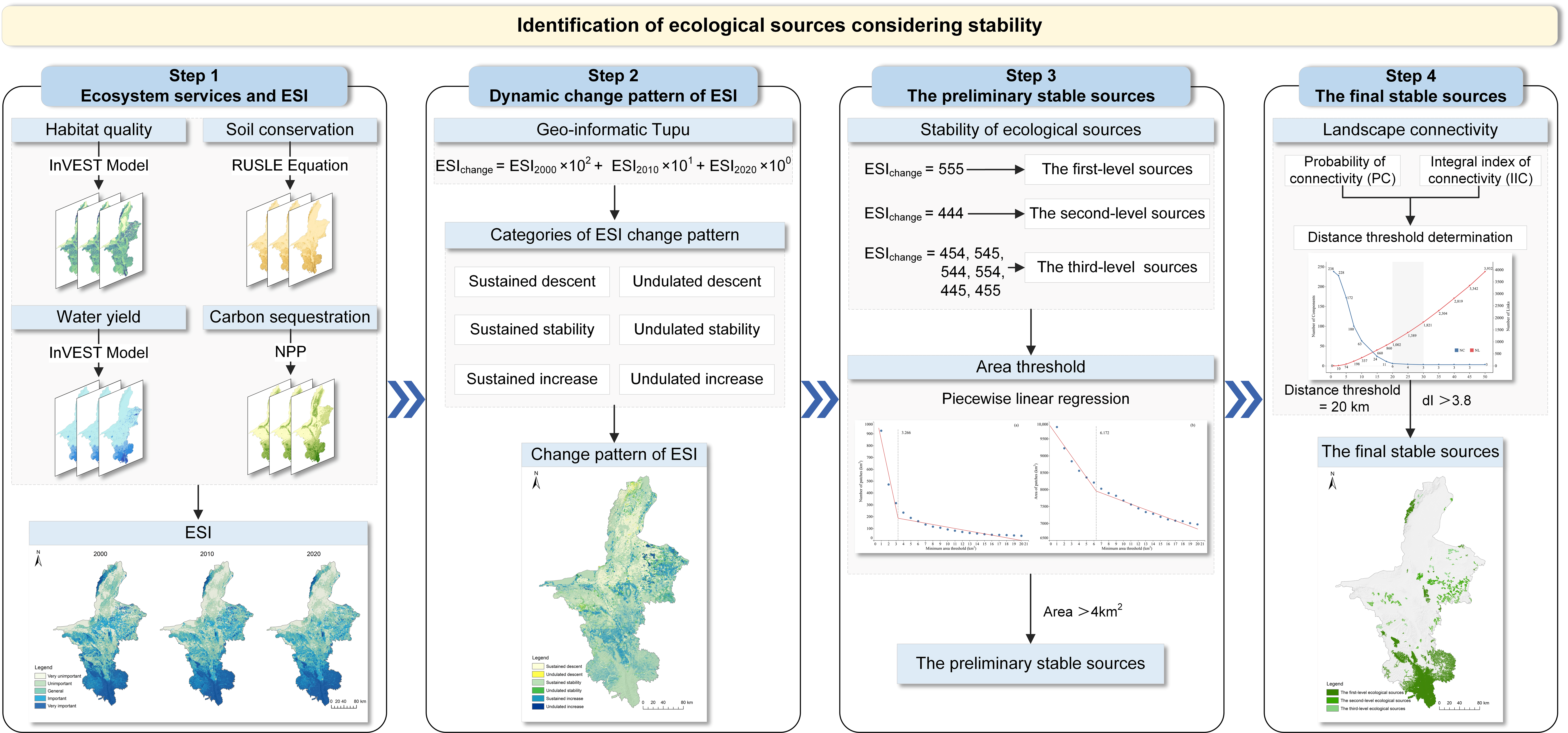
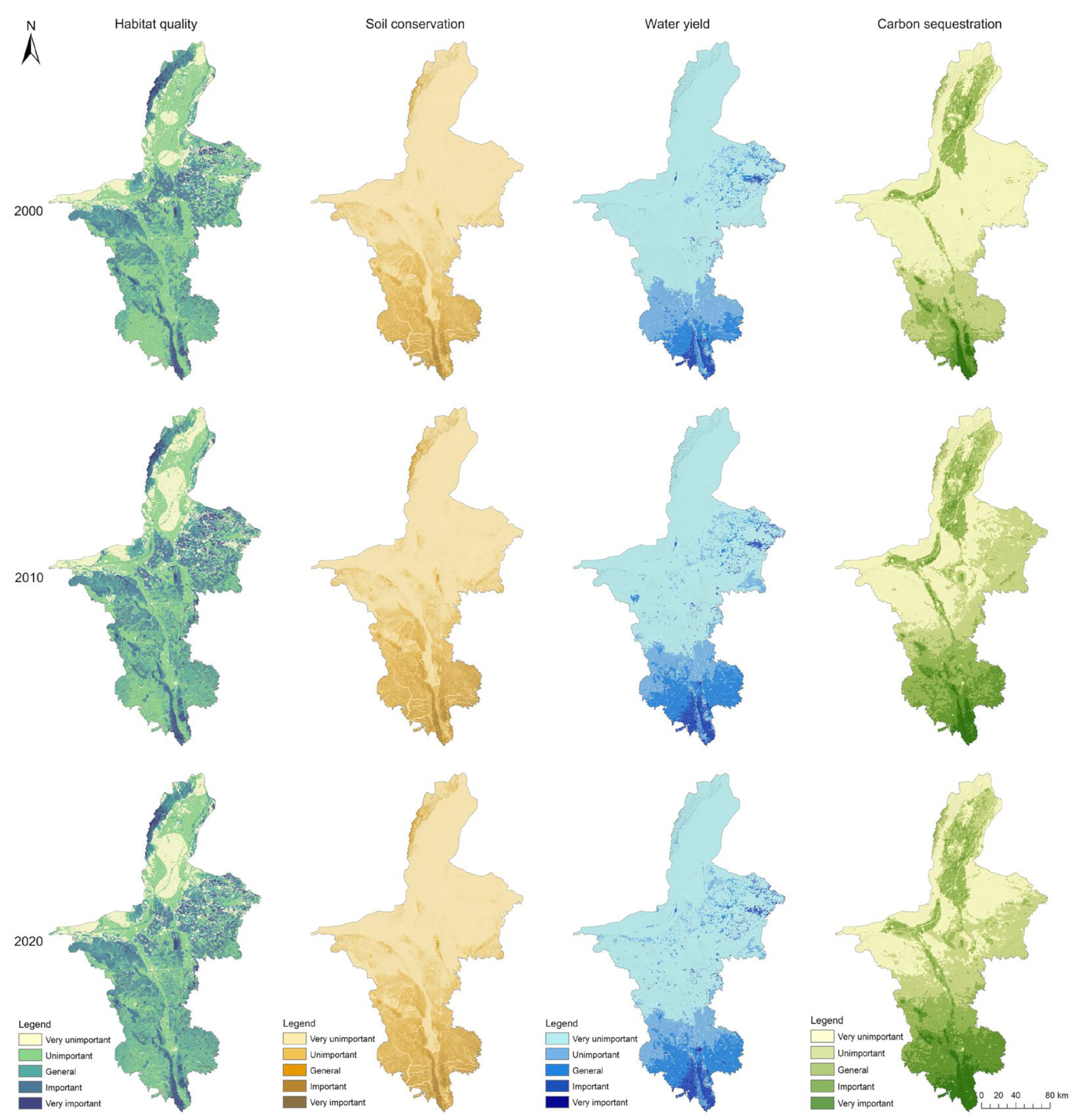
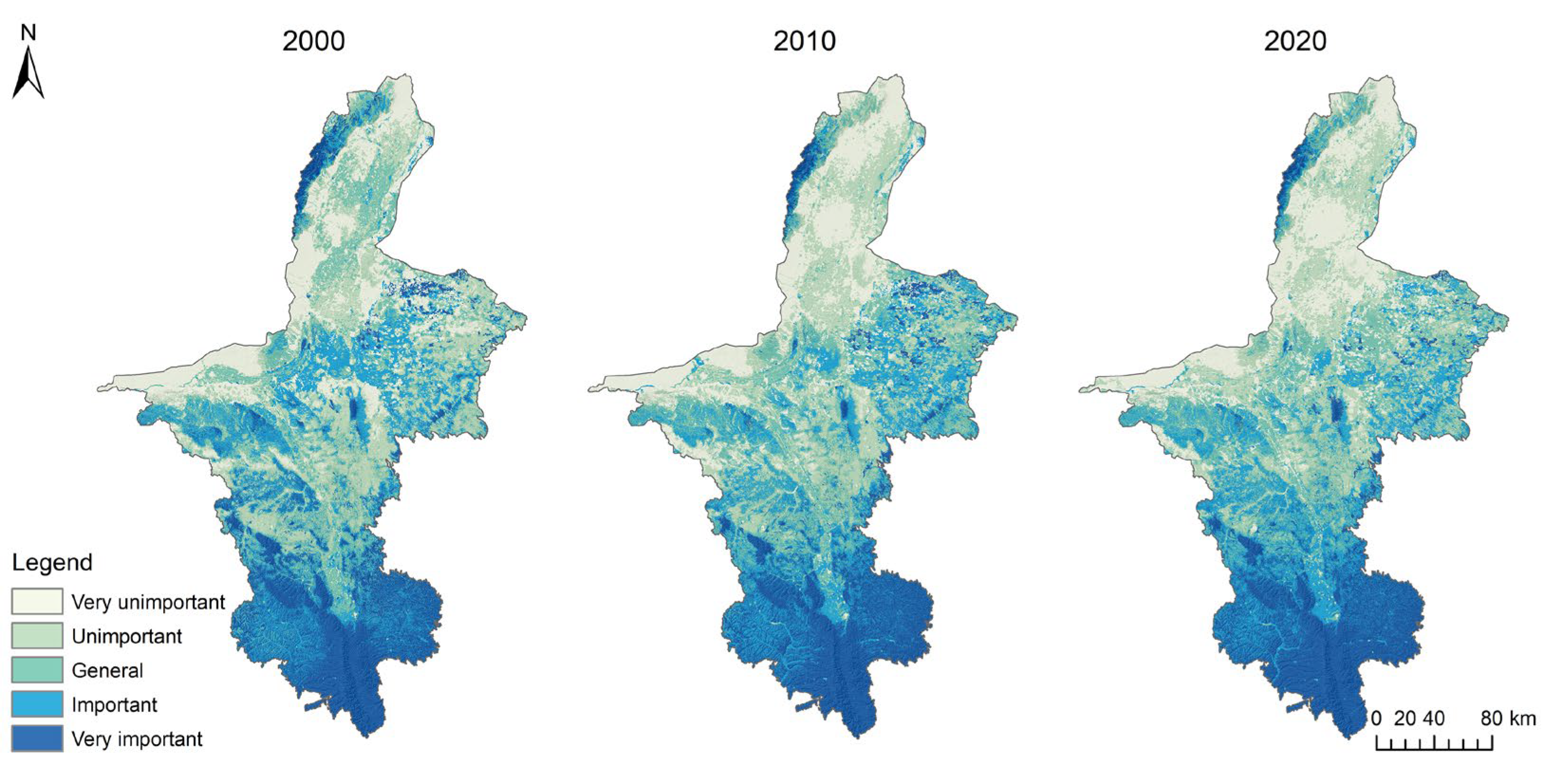
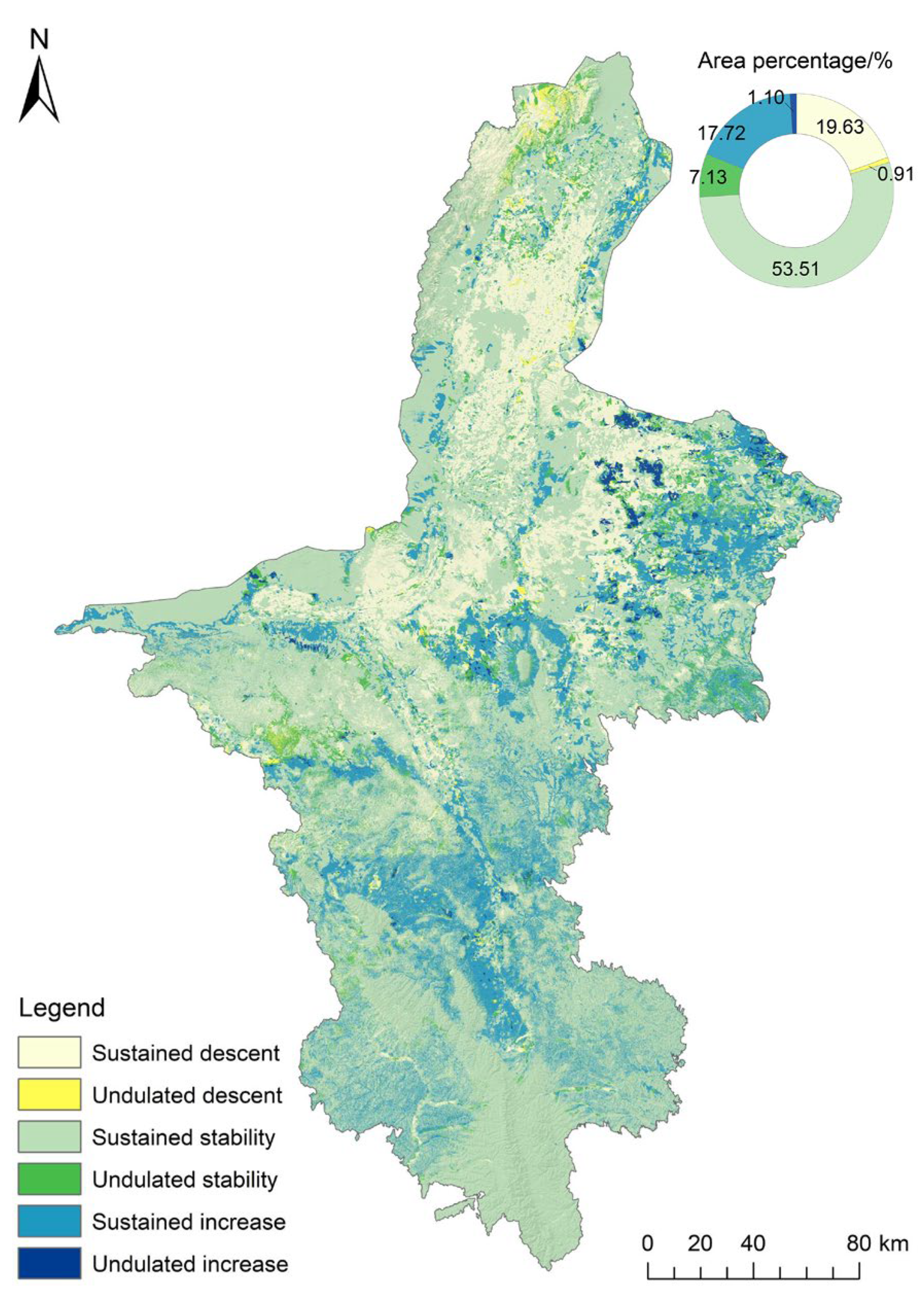
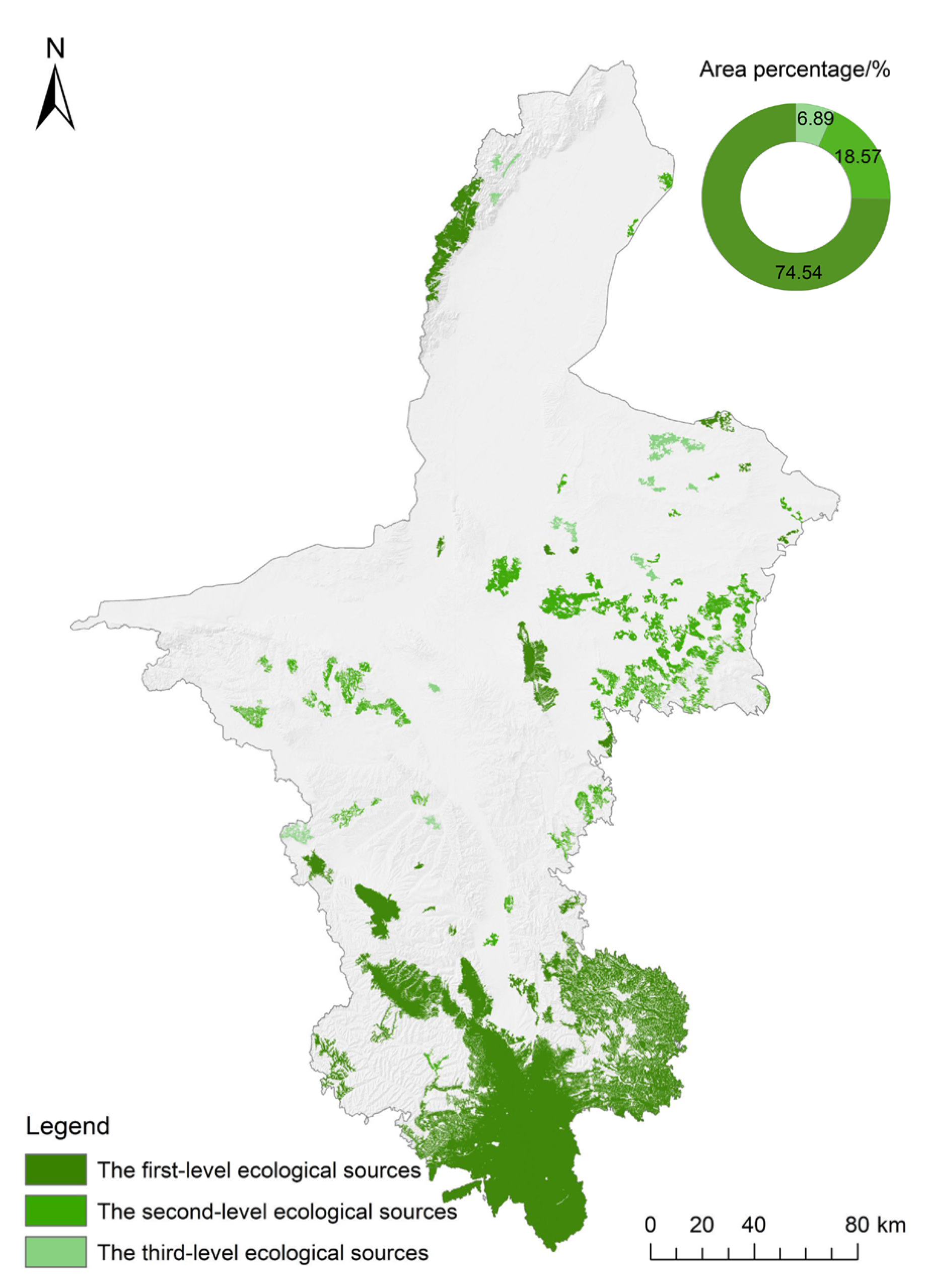

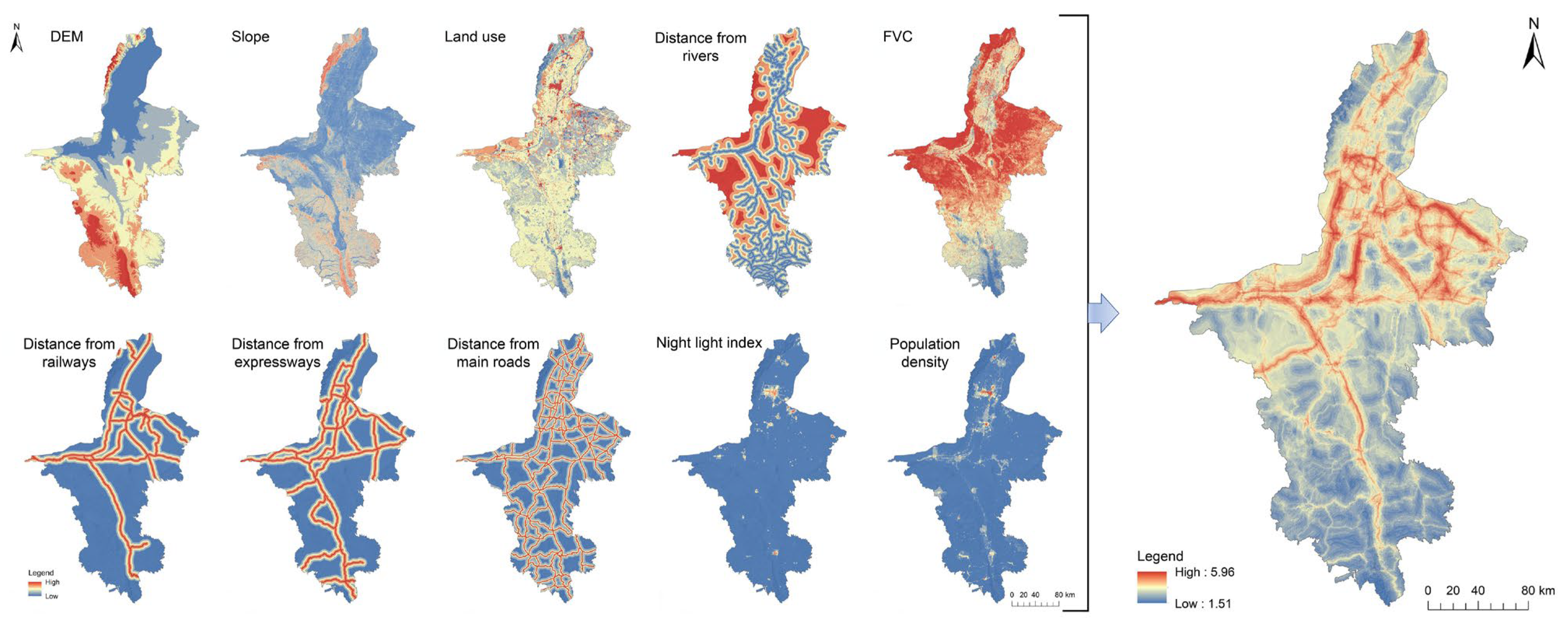
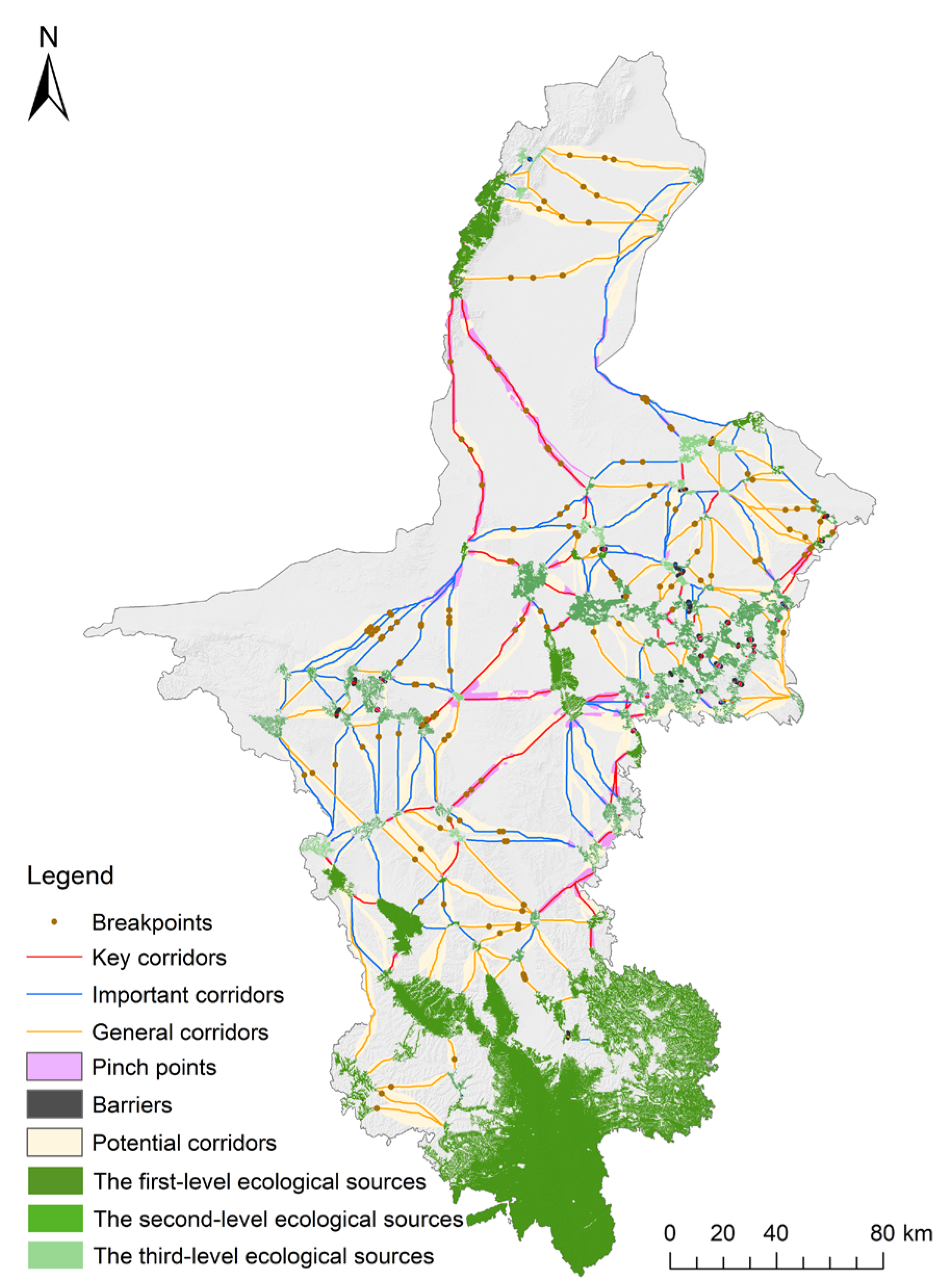
| Data | Products | Related Uses | Time/Precision Unit | Data Sources |
|---|---|---|---|---|
| Land use data | China land use/cover remote sensing monitoring database | SC, WY, HQ, Resistance factor | 2000, 2010, 2020 (30 m) | Resource and Environment Science and Data Center (http://www.resdc.cn, accessed on 25 November 2022) |
| Digital elevation model (DEM) | ASTER GDEM V3 | SC, WY, Resistance factor | 2009 (30 m) | Geospatial Data Cloud (http://www.gscloud.cn, accessed on 16 June 2022) |
| Normalized difference vegetation index (NDVI) | 30 m annual maximum NDVI dataset in China from 2000 to 2020 [40] | SC, Resistance factor | 2000, 2010, 2020 (30 m) | National Ecosystem Science Data Center (http://www.nesdc.org.cn, accessed on 8 September 2022) |
| Net primary productivity (NPP) | MOD17A3HGF | CS | 2000, 2010, 2020 (500 m) | The Land Processes Distributed Active Archive Center (LPDAAC) (https://lpdaac.usgs.gov, accessed on 8 September 2022) |
| Soil data | China soil map based harmonized world soil database (HWSD) v1.2 | SC, WY | 1995 (1:1,000,000) | National Tibetan Plateau Data Center (http://data.tpdc.ac.cn, accessed on 25 September 2022) |
| Precipitation | 1 km monthly precipitation dataset for China (1901–2020) [41] | SC, WY | 2000, 2010, 2020 (1 km) | National Tibetan Plateau Data Center (http://data.tpdc.ac.cn, accessed on 25 September 2022) |
| Evapotranspiration | 1 km monthly potential evapotranspiration dataset in China (1990–2021) [42] | WY | 2000, 2010, 2020 (1 km) | National Tibetan Plateau Data Center(http://data.tpdc.ac.cn, accessed on 25 September 2022) |
| Population density | Population Counts/Constrained Individual Countries 2020 UN Adjusted | Resistance factor | 2020 (100 m) | Worldpop Dataset (http://www.worldpop.org, accessed on 25 November 2022) |
| Nighttime light data (NTL) | VIIRS | Resistance factor | 2020 (500 m) | Earth Observation Group (https://payneinstitute.mines.edu/eog/, accessed on 25 November 2022) |
| Transportation network | China fundamental geography database | Resistance factor | 2019 (1:1,000,000) | National catalogue service for geographic information (www.webmap.cn, accessed on 11 June 2023) |
| Water network | China fundamental geography database | Resistance factor | 2019 (1:1,000,000) | National catalogue service for geographic information (www.webmap.cn, accessed on 11 June 2023) |
| Administration boundary | China fundamental geography database | The boundary of the study area | 2019 (1:1,000,000) | National catalogue service for geographic information (www.webmap.cn, accessed on 11 June 2023) |
| Types | Code Changes | Description |
|---|---|---|
| Sustained descent | 211, 221, 311, 321, 322, 331, 332, 411, 421, 422, 431, 432, 433, 441, 442, 443, 511, 521, 522, 531, 532, 533, 541, 542, 543, 544, 551, 552, 553, 554 | The ESI consistently decreased from 2000 to 2020. |
| Undulated descent | 231, 241, 251, 312, 341, 342, 351, 352, 412, 413, 423, 451, 452, 453, 512, 513, 514, 523, 524, 534 | The ESI exhibited a continuous decrease from 2000 to 2020, but there was an increasing or decreasing trend in 2010. |
| Sustained stability | 111, 222, 333, 444, 555 | The ESI remained stable from 2000 to 2020. |
| Undulated stability | 121, 131, 141, 151, 212, 232, 242, 252, 313, 323, 343, 353, 414, 424, 434, 454, 515, 525, 535, 545 | The ESI remained stable from 2000 to 2020, but there was an increasing or decreasing trend in 2010. |
| Sustained increase | 112, 113, 114, 115, 122, 123, 124, 125, 133, 134, 135, 144, 145, 155, 223, 224, 225, 233, 234, 235, 244, 245, 255, 334, 335, 344, 345, 355, 445, 455 | The ESI consistently increased from 2000 to 2020. |
| Undulated increase | 132, 142, 143, 152, 153, 154, 213, 214, 215, 243, 253, 254, 314, 315, 324, 325, 354, 415, 425, 435 | The ESI exhibited a continuous increase from 2000 to 2020, but there was an increasing or decreasing trend in 2010. |
| Resistance Classification | Resistance Factors | Resistance Coefficient | ||||
|---|---|---|---|---|---|---|
| 1 | 2 | 3 | 4 | 5 | ||
| Natural conditions | Elevation (km) | <1.3 | 1.3–1.5 | 1.5–1.8 | 1.8–2.1 | >2.1 |
| Slope (°) | <6 | 6–12 | 12–20 | 20–30 | >30 | |
| Land use types | Forest/Water | High-coverage grassland/ Medium-coverage grassland | Cropland/ Low-coverage grassland | Unused land | Urban land | |
| Distance from rivers (km) | <1 | 1–3 | 3–5 | 5–10 | >10 | |
| Human interference | Distance from railways (km) | >7.5 | 5–7.5 | 3–5 | 1–3 | <1 |
| Distance from expressways (km) | >7.5 | 5–7.5 | 3–5 | 1–3 | <1 | |
| Distance from main roads (km) | >5 | 2–5 | 1–2 | 0.5–1 | <0.5 | |
| Nighttime light index | <3 | 3–12 | 12–27 | 27–50 | >50 | |
| Population density (People/km2) | <270 | 270–1200 | 1200–3000 | 3000–6200 | >6200 | |
| Environmental response | FVC | >0.55 | 0.38–0.55 | 0.25–0.38 | 0.14–0.25 | <0.14 |
| Index Type | Restraint Factors | PC1 | PC2 | PC3 | PC4 | PC5 | PC6 | PC7 | PC8 | PC9 | PC10 |
|---|---|---|---|---|---|---|---|---|---|---|---|
| Natural conditions | Elevation | −0.452 | −0.204 | 0.449 | 0.025 | 0.099 | 0.015 | 0.113 | 0.726 | 0.043 | 0.005 |
| Slope | −0.321 | −0.226 | 0.268 | −0.216 | 0.343 | 0.558 | 0.195 | −0.510 | 0.002 | −0.008 | |
| Land use | 0.122 | 0.031 | −0.106 | 0.103 | −0.156 | −0.039 | 0.957 | 0.028 | −0.138 | −0.013 | |
| Distance from rivers | −0.081 | 0.720 | 0.588 | 0.118 | 0.047 | −0.243 | 0.046 | −0.226 | 0.019 | 0.000 | |
| Human interference | Distance from railways | 0.498 | −0.030 | 0.056 | −0.202 | 0.796 | −0.201 | 0.077 | 0.160 | −0.035 | −0.003 |
| Distance from expressways | 0.535 | −0.128 | 0.479 | −0.461 | −0.451 | 0.209 | −0.032 | 0.080 | −0.024 | 0.002 | |
| Distance from main roads | 0.337 | −0.280 | 0.287 | 0.818 | 0.037 | 0.202 | −0.081 | −0.069 | −0.047 | 0.014 | |
| Night light index | 0.042 | −0.013 | −0.012 | 0.006 | −0.003 | −0.006 | 0.080 | −0.019 | 0.526 | 0.845 | |
| Population density | 0.070 | −0.034 | −0.005 | 0.031 | −0.012 | −0.019 | 0.100 | −0.023 | 0.835 | −0.534 | |
| Environmental response | FVC | 0.131 | 0.539 | −0.232 | 0.062 | 0.083 | 0.709 | −0.030 | 0.351 | 0.034 | −0.007 |
| Principal component eigenvalues | - | 1.411 | 0.903 | 0.504 | 0.459 | 0.378 | 0.300 | 0.265 | 0.211 | 0.065 | 0.021 |
| Cumulative contribution rate (%) | - | 31.221 | 51.208 | 62.370 | 72.532 | 80.904 | 87.552 | 93.423 | 98.102 | 99.534 | 100 |
Disclaimer/Publisher’s Note: The statements, opinions and data contained in all publications are solely those of the individual author(s) and contributor(s) and not of MDPI and/or the editor(s). MDPI and/or the editor(s) disclaim responsibility for any injury to people or property resulting from any ideas, methods, instructions or products referred to in the content. |
© 2024 by the authors. Licensee MDPI, Basel, Switzerland. This article is an open access article distributed under the terms and conditions of the Creative Commons Attribution (CC BY) license (https://creativecommons.org/licenses/by/4.0/).
Share and Cite
Ma, J.; Li, L.; Jiao, L.; Zhu, H.; Liu, C.; Li, F.; Li, P. Identifying Ecological Security Patterns Considering the Stability of Ecological Sources in Ecologically Fragile Areas. Land 2024, 13, 214. https://doi.org/10.3390/land13020214
Ma J, Li L, Jiao L, Zhu H, Liu C, Li F, Li P. Identifying Ecological Security Patterns Considering the Stability of Ecological Sources in Ecologically Fragile Areas. Land. 2024; 13(2):214. https://doi.org/10.3390/land13020214
Chicago/Turabian StyleMa, Jianfang, Lin Li, Limin Jiao, Haihong Zhu, Chengcheng Liu, Feng Li, and Peng Li. 2024. "Identifying Ecological Security Patterns Considering the Stability of Ecological Sources in Ecologically Fragile Areas" Land 13, no. 2: 214. https://doi.org/10.3390/land13020214
APA StyleMa, J., Li, L., Jiao, L., Zhu, H., Liu, C., Li, F., & Li, P. (2024). Identifying Ecological Security Patterns Considering the Stability of Ecological Sources in Ecologically Fragile Areas. Land, 13(2), 214. https://doi.org/10.3390/land13020214








